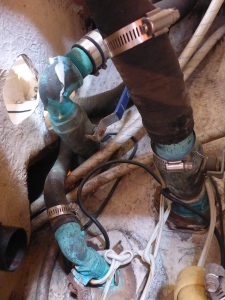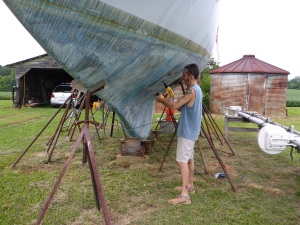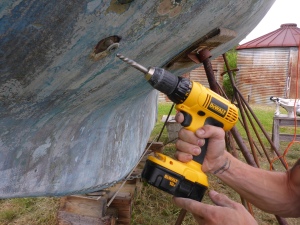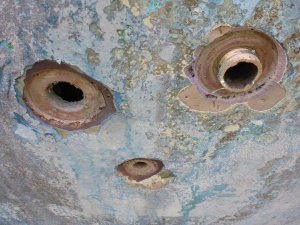This really should be called “stubborn thru hull mounted in line ball valves” but that didn’t have the same ring to it. It is, however, an apt description of why we are getting them off our boat! In my opinion (that I’m aware not everyone shares) an in line ball valve masquerading as a seacock is almost as bad as a gate valve masquerading as a ball valve! The point here is this: in my opinion gate valves and in line ball valves are inappropriate for below the waterline water ingress control.

The ABYC states that a seacock should be “operated by a lever-type handle usually operating through a 90-degree arc giving a clear indication of whether its open or shut” (ABYC H-27) and that it should “be securely mounted so that the assembly will withstand a 500 pound (227 Kg) static force applied for 20 seconds to the inboard end of the assembly, without the assembly failing to stop the ingress of water.” (ABYC H-27, 27.6.1) They keep going in H-27.6.1.3 to say that “Threads used in seacock installations shall be compatible (eg. NPT to NPT, NPS to NPS).
Given the above information an inline ball valve with its standard NPT threads mating with a standard NPS thru hull does not fit the standard from the outset. But lets add wear, corrosion, a few accidental bumps here and there, some rough seas to loosen everything up and then apply 500 pounds to our ball valve. Honestly, I wouldn’t trust the 500 pound test on a new install of an inline ball valve. Here’s why: because our lives may depend on the integrity of the fitting. So why mess around? Why not do it right? This is not an area that I feel the desire to skimp on to save a few bucks.
To drive it home and get off my soapbox, when I applied moderate force in a confined area without good leverage, all three of the pictured inline ball valves failed. I was lucky to be on the hard. I’ve heard stories of less fortunate people who were floating when their foot slipped and suddenly they had a pretty big hole in their boat!
So, now that everyone knows how I feel about ’em – lemme show you how I got rid of ’em! It was a real challenge. The threads were completely seized – two weeks of soaking in PB Blaster didn’t even touch them. So without the ability to get the ball valves off the thru hull I had to resort to drastic measures. With the help of Erin inside and me outside with a drill and bit made for backing out large bolts we unscrewed the thru hull down and out from the retaining ring.
Once we got the thru hull an inch or two out of the hull I was able to cut it off with an angle grinder. We then pulled the whole assembly up and out to the trash from the inside.
And there you have it, three fresh holes in the boat needing a lot of love and cleaning up before we install proper flanged seacocks. Seacocks with an integral flange meet all of the ABYC standards and are the only thru hull fittings we will have on the boat.
Seacocks like this bad boy right here:







2 thoughts on “Stubborn Seacocks”